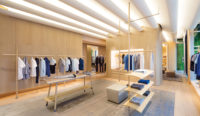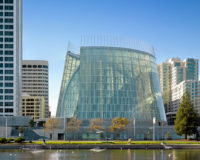New Haven, Connecticut
While regarded as one of Eero Saarinen's most distinctive works during his short career, the Morse and Ezra Stiles Colleges at Yale University (1958–62) in New Haven have long seemed more appealing in photographs than in real life. Part of the reason is the surrounding competition: When you walk past the chunky, textured stone of the Collegiate Gothic residential colleges designed by James Gamble Rogers from 1925 to 1934, it's a little hard to adore the pasty, raw concrete and stone aggregate surfaces of Saarinen's stolid clusters. Even Vincent Scully, master of Morse College from 1969 to 1975, admits, “I liked Rogers's Branford and Berkeley better, but I didn't have a choice. [Yale president] Kingman Brewster assigned me to Morse because of my association with modern architecture.”
Saarinen, who had studied at Yale in the 1930s, was aware of Yale's obsession with residential Collegiate Gothic (or Georgian) quadrangles, many of which were coming to completion while he was there. By the time Saarinen got the commission to design Morse and Stiles in the late 1950s, he had studied such historic settings as Italy's village of San Gimignano and the Campo in Siena. His scheme for the Yale colleges featured four-story housing punctuated by a 10-story tower and a 14-story one. The complex embraced a grassy crescent courtyard, hemmed on the other side by Tower Parkway. Saarinen intended the complex at the western edge of campus to be a porous village, with pathways allowing more freedom of pedestrian movement than found in the enclosed quadrangles. But by the late 1960s, with student unrest, town-gown problems, and the admission of women, the village turned into a castle keep under lock and key.
Rather than resort to stone or brick, Saarinen built the colleges of poured-in-place concrete. He mixed in a large-scale, crushed granite so the aggregate would have a flinty, hard, angular quality. Yet the resulting exterior, notes Scully, is “kind of soft and flat-looking, like adobe.” The battlement massing was unforgiving. Scully recalls, “Paul Rudolph [chair of the School of Architecture from 1958–67] used to say it looked like a set for Ivanhoe.”
Today the modern-medieval fortress has softened with age—although it could stand a bit more ivy. When Yale decided it was time to renovate and expand the colleges, it hired KieranTimberlake Architects (KTA) to remedy problematic features that had existed since 1962. One of KieranTimberlake's assignments was to reconfigure the living quarters for the 500 students. (Each residential college also includes a Saarinen-designed house for the master, plus accommodations for each dean and two fellows.) Saarinen, in accordance with a wish expressed by a student survey, had designed the rooms as stand-alone singles. But over the years, it became clear that the students wanted single rooms that were integrated into suites, typical of Yale's other residential colleges. KTA, which already had redone Berkeley, Silliman, Pierson, and Davenport Colleges, carried out the mission with jigsaw-puzzle precision.
In its 285,000-square-foot renovation and expansion, the Philadelphia firm preserved the concrete and stone exterior but added 25,000 square feet of new construction underground. In doing so, KTA reclaimed basement areas and created a two-level addition extending underneath the crescent courtyard on the northwest side of the complex. Here now are new social and recreational spaces—a theater, as well as arts, dance, exercise, and music studios—that budget cuts hobbled in the original. “Putting in foundations and waterproofing was a structural tour de force,” says KTA's Stephen Kieran. “Conceptually, we poured forms and spaces like lava under the existing buildings and let them flow out.”
To get light into the underground spaces, the architects carved out a below-grade court in the space between the two colleges and redesigned the moatlike walls edging the colleges to incorporate skylights. They cut up the original concrete walls of the moats into panels and combined them with new board-form concrete ones. The subterranean concrete and steel-beam structure also includes massive tree wells for new planting above, while a steel and wood bridge spans the sunken court.
KTA also redesigned the two smaller sloping grassy courtyards on the south; now Morse's and Stiles's dining halls open onto outdoor ipé wood decks. Reclaimed storm water trickles down the terraced landscape the students refer to as “the beach.”
One of the more dramatic transformations involved reworking the common rooms across the entryways from the dining halls. Saarinen had hoped to create rathskeller-like spaces, which he did using a concrete hexagonal columns with radiating ribs that create triangular coffers. The architectonic ceiling was never appreciated because the rooms were so dark. Since KTA inserted concrete and glass monitors between the arms of the ribs, and changed the floors from a dark slate to oak, more students have been attracted to the lighter common rooms.
All in all, the renovation and spatially complex underground expansion keep Saarinen's architecture intact, while evoking as well Louis Kahn's rugged concrete forms and Carlo Scarpa's detailing of materials. More important, getting rid of the old palace-basement sensibility appears to be successful with the residents. According to the current master of Morse College, Frank Keil, and the master of Stiles, Stephen Pitti, the students now want to be assigned to the colleges—a far cry from the days when they asked to be transferred out.
Total construction cost: Withheld at client’s request
Completion Date: September 2011
Gross square footage: 285,000 SF (260,000 existing/renovated, 25,000 addition)
PeopleOwner: Yale University Architect Personnel in architect's firm who should receive special credit: Interior designer: Marguerite Rodgers, Ltd. Engineer(s) Civil: URS Corporation Consultant(s) Lighting: ARUP Acoustical: Metropolitan Acoustics Other: General contractor The Whiting-Turner Contracting Company (Pre-construction) Photographer(s) Peter Aaron/www.ottoarchive.com CAD system, project management, or other software used: Autodesk Revit, Vela Systems |
ProductsStructural system Manufacturers of structural components unique to this project: Exterior cladding Metal/glass curtain wall: Schüco50+ S Moisture barrier: Exterior Wood Decking and Screens: Roofing Windows Glazing Doors Metal doors: Wood doors: Sliding doors: Fire-control doors, security grilles: Special doors: Upswinging doors, other: Hardware Closers: Exit devices: Pulls: Security devices: Interior finishes Suspension grid: Cabinetwork and custom woodwork: Paints and stains: Wall coverings: MDC Wallcoverings (Digital wallpaper for servery) Paneling: Plastic laminate: Solid surfacing: Special surfacing: Floor and wall tile: Resilient flooring: Marmoleum Carpet: Special interior finishes unique to this project: Furnishings Reception furniture: Fixed seating: Chairs: Tables: Upholstery: Other furniture: Lighting Exterior: Dimming System or other lighting controls: Conveyance Accessibility provision: Plumbing |
















Post a comment to this article
Report Abusive Comment